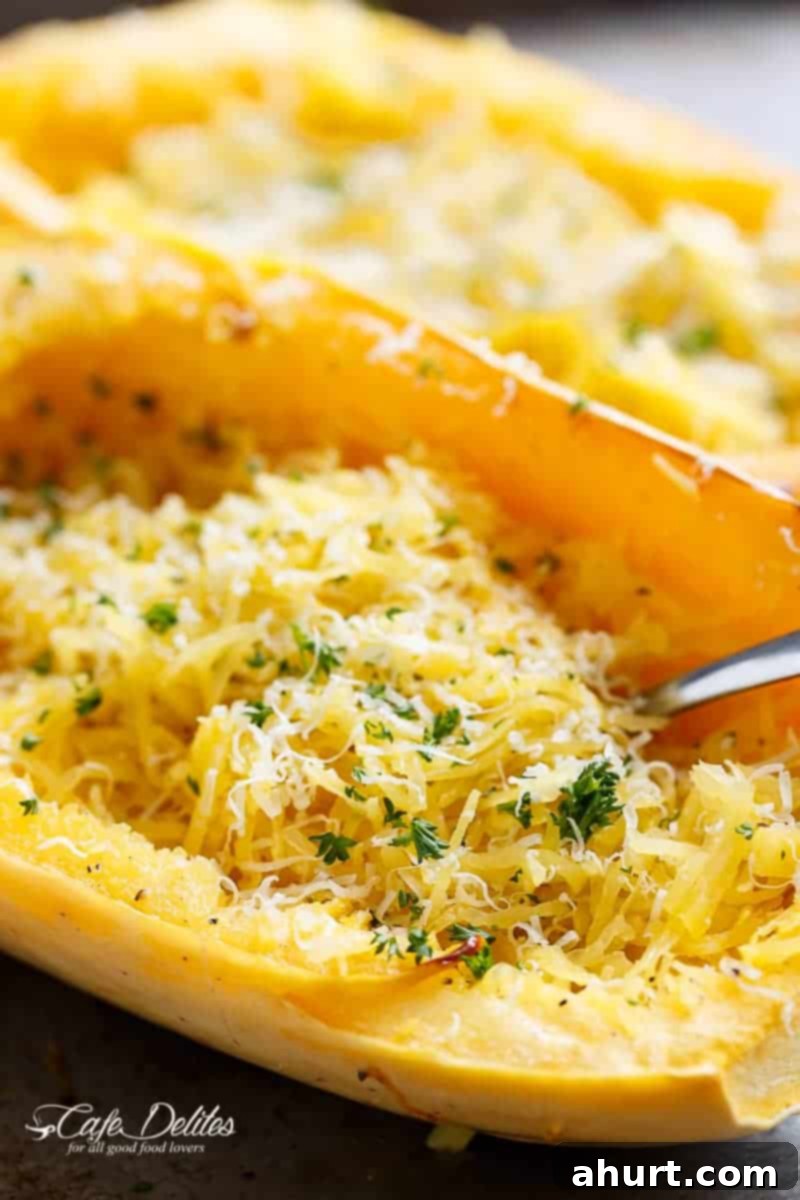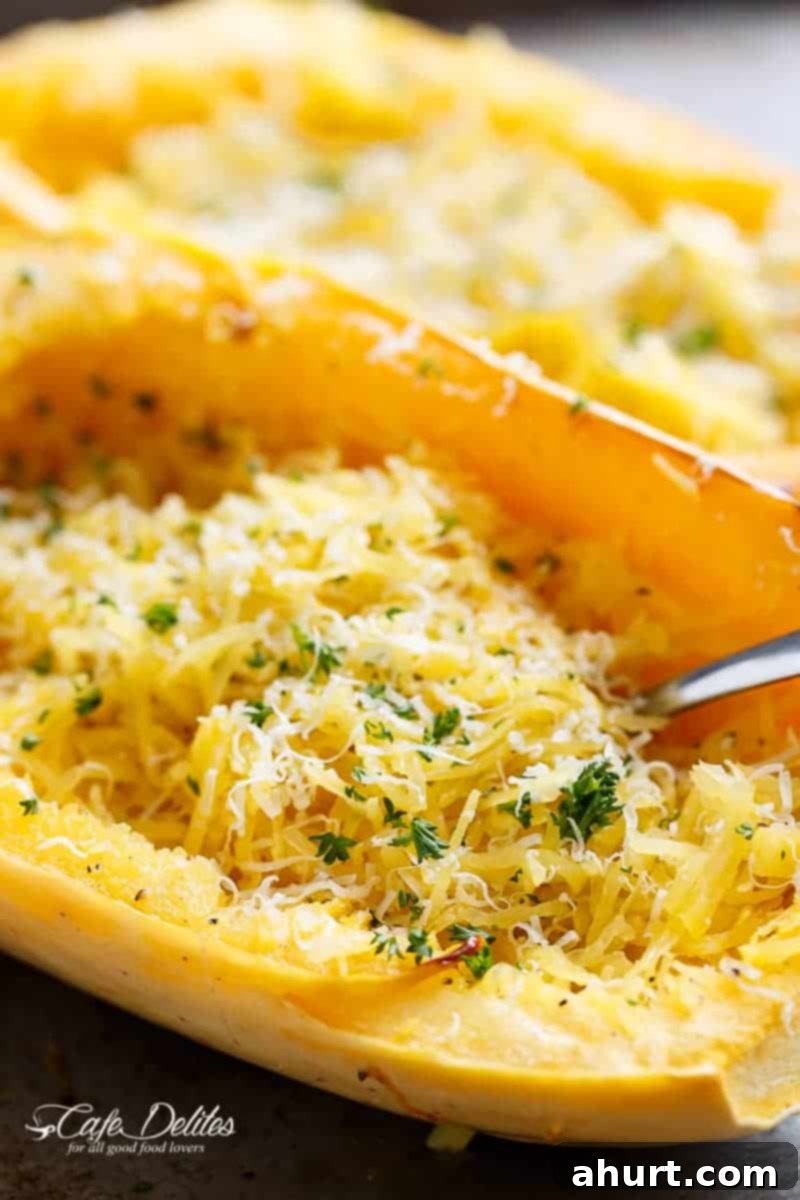Mastering Spaghetti Squash: Your Ultimate Guide to Easy Oven & Microwave Cooking for Healthy, Low-Carb Meals
Welcome to the definitive guide for preparing delicious spaghetti squash, a true culinary marvel whether cooked in the oven or microwave. This versatile golden vegetable is a dream come true for anyone seeking a low-carb and low-calorie alternative to traditional pasta, allowing you to enjoy lighter meals without ever compromising on flavor or satisfaction. Its unique ability to transform into tender, pasta-like strands makes it an invaluable addition to any healthy eating plan.
Whether your goal is a simple, nutritious side dish or a complete pasta swap that perfectly aligns with your dietary preferences, this comprehensive guide will provide you with clear, step-by-step instructions. You’ll learn exactly how to prepare spaghetti squash, ensuring perfect results every time. Once you discover the ease and deliciousness of these methods, you’ll understand why so many home cooks turn to a comforting spaghetti squash recipe when they crave something hearty, incredibly healthy, and remarkably easy to make.

Why Spaghetti Squash? The Health Benefits
Beyond its impressive ability to mimic pasta, spaghetti squash boasts an array of health benefits that make it an excellent choice for a balanced diet. It’s notably low in calories and carbohydrates, making it ideal for those following ketogenic, low-carb, or weight-loss diets. Unlike traditional pasta, it’s packed with dietary fiber, which aids digestion, promotes satiety, and helps regulate blood sugar levels. This means you feel fuller for longer, reducing the urge to overeat.
Furthermore, spaghetti squash is a good source of essential vitamins and minerals, including Vitamin A, Vitamin C, Vitamin B6, potassium, and manganese. These nutrients support immune function, skin health, and overall well-being. By incorporating spaghetti squash into your meals, you’re not just enjoying a delicious dish; you’re actively nourishing your body with nutrient-dense goodness. It’s truly a smart swap for a healthier lifestyle, offering flavor and nutrients without the carb load.
What Makes This Recipe Work So Well
Cooking spaghetti squash at home is surprisingly straightforward, and this recipe provides two foolproof methods: the classic oven roast and the quick microwave approach. Both techniques are designed to perfectly bring out the natural sweetness of the squash while yielding those distinct, tender strands that beautifully resemble traditional pasta. Whether you prefer the deeper, slightly caramelized flavor developed through roasting or the speed and convenience of microwaving, you’ll achieve fantastic results.
The true brilliance of this recipe lies in its incredible versatility. You can savor it simply on its own, perhaps tossed with a knob of butter, a sprinkle of Parmesan, and fresh herbs, making it an exquisite side dish. Alternatively, it serves as the ultimate low-carb foundation for your favorite sauces, from rich Bolognese to creamy Alfredo. With our clear, step-by-step instructions and simple, yet effective, seasonings, you are guaranteed to get squash that is always flavorful, perfectly tender, and never watery. This reliable spaghetti squash recipe will quickly become a go-to in your culinary repertoire, providing a healthy and satisfying meal option time and time again.
Essential Ingredients for Flavorful Spaghetti Squash
Transforming spaghetti squash into a light, flavorful, and satisfying dish requires only a handful of simple ingredients. Each component plays a crucial role in making this recipe both easy to execute and incredibly delicious, enhancing the natural flavors of the squash.
- Spaghetti Squash: The unequivocal star of our dish! When properly cooked, its vibrant golden flesh effortlessly separates into delicate, pasta-like strands. These versatile strands can serve as a wholesome side dish, a light main course, or a superb base for various sauces. Look for a squash that feels heavy for its size and has firm, unblemished skin.
- Olive Oil: A touch of good quality olive oil is essential. It not only adds a wonderful richness and depth of flavor but also helps the edges of the squash achieve a beautiful caramelization during roasting, enhancing its natural sweetness. For microwaving, it helps moisten and flavor the squash.
- Salt: A fundamental seasoning. Just a pinch of salt is enough to enhance the inherent sweetness of the squash, balancing out its earthy notes and bringing all the flavors into harmony. Always season to your taste preference.
- Ground Pepper: A dash of freshly ground black pepper adds a subtle warmth and a gentle kick, elevating the overall flavor profile of every single bite. It provides a perfect counterpoint to the squash’s sweetness.
Optional Flavor Enhancements:
- Garlic Powder or Fresh Minced Garlic: For a savory boost, add a sprinkle of garlic powder or rub the cut surfaces with fresh minced garlic before cooking.
- Dried Herbs: Italian seasoning, dried thyme, or oregano can add an aromatic depth.
- Red Pepper Flakes: A pinch for those who enjoy a little heat.
- Butter: For a richer flavor, drizzle with melted butter after cooking, before shredding.
- Parmesan Cheese: A generous sprinkle of grated Parmesan cheese after shredding is always a welcome addition, adding a salty, umami note.
Note: Please see the recipe card at the bottom of this page for a full list of ingredients with precise measurements.
Step-by-Step: How To Make Spaghetti Squash Perfectly
Preparing spaghetti squash is simpler than you might think, and we’re covering two fantastic methods to ensure you get perfect, tender, pasta-like strands every time. Choose the oven-roasting method for a deeper flavor, or the microwave for ultimate speed.
- Preheat and Prepare: If you’re opting for the oven, preheat your oven to 375°F (190°C). Lightly grease a baking sheet or tray with a thin layer of olive oil or nonstick spray. For the microwave method, simply set aside a large microwave-safe dish ready for use.
- Cut and Clean: Begin by thoroughly washing the exterior of your spaghetti squash under cool running water. Next, carefully slice the squash in half lengthwise from the stem to the tail. A sharp, heavy knife can make this task easier. Once halved, use a sturdy spoon to scoop out and discard all the seeds and stringy membranes from the center of each half, just like you would with a pumpkin.
- Season Well: With the cut sides facing up, brush a light, even coating of olive oil over the flesh of each spaghetti squash half. Then, generously sprinkle both halves with salt and freshly ground black pepper. This simple yet crucial step not only infuses the squash with flavor but also encourages a beautiful caramelization on the edges during roasting, enhancing its natural sweetness.
- Cook Until Tender:
- Oven Method: Place the seasoned squash halves cut-side down on your prepared baking sheet. Roast in the preheated oven for approximately 35–50 minutes. The exact cooking time will vary depending on the size of your squash.
- Microwave Method: Place the seasoned squash halves cut-side down in a large microwave-safe dish. Pour about 1 inch of water into the bottom of the dish. Microwave on HIGH power for 15–20 minutes.
- Cool and Test: Regardless of the cooking method, check for doneness by carefully piercing the skin and flesh with a fork. It should slide in easily with minimal resistance. Once tender, remove the squash from the oven or microwave and allow it to cool slightly for a few minutes. This cooling period is important, not just for safe handling, as the steam inside can be very hot, but also to allow the strands to set.
- Scrape Into Strands: Once cool enough to handle, use a fork to gently scrape the cooked flesh of the squash. Work your way from the outside in, pulling the fork back and forth across the squash until long, delicate spaghetti-like strands naturally form. These strands are your healthy, low-carb pasta substitute! Serve immediately as a delicious side dish, or use it as a base for your favorite healthy main courses.
Spaghetti squash is incredibly versatile. Swap it out for traditional pasta in your cherished recipes and let its unique texture and mild flavor shine. For a fresh, herby, and satisfying twist that feels light yet hearty, try it in place of noodles in Basil Pesto Chicken Spaghetti. It also makes a superb low-carb alternative in Slow Cooker Spaghetti Bolognese, beautifully absorbing all the rich, slow-simmered flavors of the sauce. For a creamy and utterly comforting dish, use spaghetti squash instead of pasta in Creamy Tomato Pasta – a simple switch that still delivers all the beloved flavors and textures you crave, but with added nutritional benefits.
Tips for Success: Achieving the Best Spaghetti Squash Every Time
While cooking spaghetti squash is straightforward, a few key tips can elevate your results from good to absolutely perfect:
- Choose Wisely: Select a spaghetti squash that is firm, heavy for its size, and has no soft spots or blemishes. A vibrant yellow skin indicates ripeness and a sweeter flavor.
- Safety First When Cutting: Spaghetti squash can be tough to cut. For easier and safer slicing, carefully pierce the skin a few times with a knife, then microwave the whole squash for 3-5 minutes. This softens the skin slightly, making it much easier to cut lengthwise. Always use a sharp, heavy knife on a stable cutting board.
- Don’t Overcook: Overcooked spaghetti squash can become mushy and watery, losing its desirable strand-like texture. It’s better to undercook slightly and check for doneness frequently. The fork should pierce the skin and flesh with ease, but the flesh should still hold its shape before shredding.
- Cut-Side Down for Roasting: Placing the squash cut-side down on the baking sheet helps to steam the flesh while roasting, keeping it moist and tender, and preventing it from drying out.
- Add Moisture for Microwaving: The inch of water in the microwave-safe dish is crucial. It creates steam, which cooks the squash evenly and prevents it from drying out or becoming rubbery.
- Rest Before Shredding: Allowing the squash to cool for a few minutes after cooking makes it easier and safer to handle. It also allows the internal steam to dissipate slightly, preventing a watery result and helping the strands form better.
- Seasoning is Key: Don’t be shy with salt and pepper. These basic seasonings bring out the best in the squash’s natural flavor. Consider adding other spices like garlic powder, onion powder, paprika, or a blend of Italian herbs for extra layers of taste.
- Storing Leftovers: Cooked spaghetti squash can be stored in an airtight container in the refrigerator for up to 3-4 days. It reheats well in the microwave or a skillet.
- Freezing: You can freeze cooked spaghetti squash for longer storage. Once shredded, let it cool completely, then portion it into freezer-safe bags or containers. It can be frozen for up to 3-4 months. Thaw in the refrigerator overnight before reheating.
Versatile Serving Suggestions & Flavor Pairings
The beauty of spaghetti squash lies not just in its health benefits and ease of preparation, but in its incredible adaptability to a myriad of dishes. It’s a fantastic canvas for countless flavors and culinary creations:
- Classic Pasta Alternative: The most popular use! Replace any pasta in your favorite recipes.
- Bolognese: Serve with a hearty meat sauce for a satisfying, low-carb “spaghetti” Bolognese.
- Pesto: Toss with fresh basil pesto, cherry tomatoes, and grilled chicken for a light and vibrant meal.
- Alfredo: Creamy Alfredo sauce clings beautifully to spaghetti squash strands, creating a rich yet lighter dish.
- Marinara: A simple marinara sauce with meatballs or Italian sausage is always a hit.
- Simple Side Dish: For a quick and easy accompaniment, keep it minimal.
- Toss with butter, Parmesan cheese, and fresh parsley or chives.
- Drizzle with olive oil, lemon juice, and a sprinkle of red pepper flakes.
- Mix with roasted garlic, a touch of cream, and fresh basil.
- Casseroles and Bakes: Spaghetti squash is excellent in baked dishes.
- Cheesy Squash Bake: Combine with cheese (mozzarella, cheddar), a creamy sauce, and perhaps some cooked chicken or spinach, then bake until bubbly.
- Tuna Casserole Reinvented: Use spaghetti squash instead of noodles in your favorite tuna casserole recipe for a healthier twist.
- Stir-Fries and Bowls: Add a unique texture to Asian-inspired dishes.
- Incorporate into stir-fries with your favorite vegetables and protein.
- Use as a base for healthy Buddha bowls, topped with roasted veggies, a protein, and a flavorful dressing.
- Soups and Salads: Don’t limit it to hot dishes!
- Add cooled spaghetti squash strands to a vibrant green salad for extra texture and nutrition.
- Stir into brothy soups at the last minute for a noodle-like addition.
The key is to think of spaghetti squash as a neutral base that can absorb and complement a wide range of flavors. Experiment with your favorite herbs, spices, and sauces to discover new and exciting ways to enjoy this incredible vegetable.
Recipe FAQ’s
Both oven roasting and microwaving are excellent methods, and the “best” choice often depends on your preference and available time. Oven roasting, typically around 35-50 minutes, yields a slightly richer, more caramelized flavor due to the dry heat, which many find superior. Microwaving, taking only 15-20 minutes, is perfect if you need a quick, convenient option and still produces wonderfully tender strands. Both methods are great, so choose the one that suits your schedule!
Spaghetti squash is incredibly versatile! It’s famously used as a low-carb alternative to pasta in dishes like Bolognese, pesto spaghetti, creamy tomato sauce, or even Alfredo. Beyond pasta swaps, it makes a delicious simple side dish tossed with butter, fresh herbs, and Parmesan cheese. You can also incorporate it into stir-fries, casseroles, or use it as a base for healthy grain bowls. Its mild flavor pairs well with almost any protein, such as grilled chicken, fish, or ground beef.
Absolutely! Spaghetti squash is a fantastic healthy alternative to regular wheat pasta. It’s significantly lower in carbohydrates and calories, making it ideal for those managing weight or following low-carb diets. Moreover, it’s rich in dietary fiber, which aids digestion and promotes a feeling of fullness, and provides essential vitamins and minerals like Vitamin A, C, and potassium. It offers a nutrient-dense, guilt-free way to enjoy your favorite pasta dishes.
Spaghetti squash can be tough to cut. To do so safely, use a large, sharp chef’s knife. For extra ease, you can carefully pierce the skin in a few spots and microwave the whole squash for 3-5 minutes before cutting. This softens the rind slightly. Place the squash on a non-slip cutting board and slice it lengthwise from stem to tail. If the stem is too hard, you can trim both ends first.
Yes, cooked spaghetti squash stores very well. Once it has cooled completely, transfer the shredded strands to an airtight container and refrigerate for up to 3-4 days. It can be reheated gently in the microwave or briefly sautéed in a skillet. For longer storage, you can also freeze cooked spaghetti squash for up to 3-4 months. Thaw it in the refrigerator overnight before use.


Saved
Pin
How To Cook Spaghetti Squash
Karina
15 minutes
35 minutes
50 minutes
4
people
Ingredients
-
2
spaghetti squash
about 2 pounds or 1 kilo each (choose firm, unblemished squash) -
1-2
tablespoons
olive oil -
1
pinch
salt
to taste (enhances natural sweetness) -
1
pinch
ground pepper
to taste (adds warmth and depth)
Instructions
Oven Roast Method (Preferred for Best Flavor):
-
Preheat & Prepare: Preheat your oven to 375°F (190°C). Lightly grease a large baking sheet or tray with a brush of olive oil or use a nonstick cooking spray. This prevents sticking and helps with easy cleanup.
-
Cut & Clean Squash: Thoroughly wash the outside of the spaghetti squash. Using a sharp, heavy knife, carefully cut the squash in half lengthwise from stem to tail. If the stem is too tough to cut through, you can trim the ends of the squash first to create a flat surface. Use a spoon to scoop out and discard all seeds and stringy membranes from the middle of each half, just like preparing a pumpkin.
-
Season: Brush the cut surfaces of both squash halves with a light coating of olive oil. Season generously with salt and pepper to taste. You can also add garlic powder or your favorite herbs at this stage.
-
Roast: Arrange the seasoned spaghetti squash halves on the prepared baking sheet, cut-side down. Roast in the preheated oven until the flesh is tender when pierced with a fork (this usually takes about 35-50 minutes, depending on the size of your squash).
Test for Doneness: The squash is ready when a fork easily pierces through the skin and flesh. Avoid overcooking to prevent a watery or mushy texture.
-
Cool & Shred: Carefully remove the squash from the oven and allow it to cool for a few minutes before handling. The steam can be very hot. Once slightly cooled, use a fork to scrape the flesh back and forth across the squash. The cooked flesh will naturally separate into long, spaghetti-like strands! Serve warm as desired.
Microwave Method (For Speed & Convenience):
-
Prepare Squash: Follow step 2 from the Oven Roast Method: wash the squash, then cut it in half lengthwise and scoop out the seeds and stringy bits. You can lightly brush with olive oil and season with salt and pepper now or after cooking, depending on preference.
-
Arrange in Dish: Place the squash halves cut-side down in a large microwave-safe baking dish. Ensure the dish is large enough to comfortably fit both halves.
-
Add Water: Fill the bottom of the dish with approximately 1 inch of water. This water will create steam in the microwave, helping the squash cook evenly and stay moist.
-
Microwave First Cook: Microwave on HIGH power for 15 minutes. After 15 minutes, carefully check the squash for softness by piercing the skin and flesh with a fork.
-
Continue Cooking (if needed): If the squash is not yet tender in the middle, return it to the microwave and cook for additional 5-minute intervals until it reaches the desired softness. Total microwave time typically ranges from 15-25 minutes.
-
Cool & Shred: Carefully remove the hot squash from the microwave and allow it to cool for a few minutes. Once cool enough to handle, use a fork to scrape the flesh, pulling back and forth to create the distinct spaghetti-like strands. If you didn’t season before, now’s the time to add olive oil, salt, and pepper, or any other desired toppings.
Notes
*Always check for doneness around the 30-minute mark for oven roasting (or 15 minutes for microwaving) and then at regular intervals. It’s crucial not to overcook the squash, as it can become overly mushy and watery in the middle, which will prevent it from forming those desirable natural spaghetti-like strands. A perfectly cooked squash will be tender but still hold its shape before shredding.
Nutrition
Calories:
181
kcal
|
Carbohydrates:
33
g
|
Protein:
3
g
|
Fat:
6
g
|
Saturated Fat:
1
g
|
Polyunsaturated Fat:
2
g
|
Monounsaturated Fat:
3
g
|
Sodium:
92
mg
|
Potassium:
522
mg
|
Fiber:
7
g
|
Sugar:
13
g
|
Vitamin A:
579
IU
|
Vitamin C:
10
mg
|
Calcium:
111
mg
|
Iron:
2
mg
Nutrition information is automatically calculated, so should only be used as an approximation.
Tried this? Leave a comment below!
